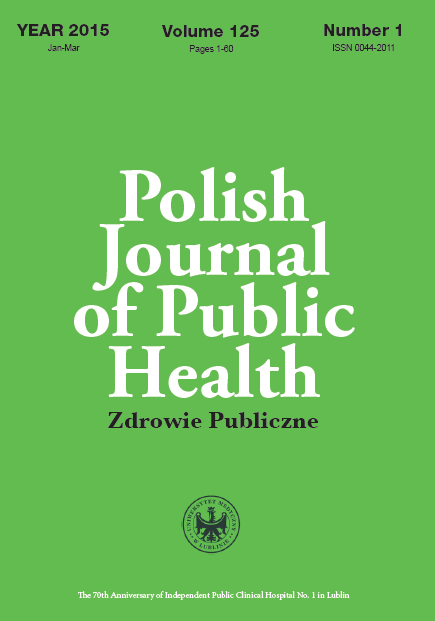Diabetes mellitus type 2 in the elderly
DOI:
https://doi.org/10.1515/pjph-2015-0021Słowa kluczowe:
diabetes mellitus type 2, geriatrics, elderly, hypoglycaemiaAbstrakt
The number of patients with type 2 diabetes increases along with civilizational development. Advanced treatment methods applied in diabetology and other branches of medicine increase the number of patients. The aim of this work is to present diagnostic and therapeutic problems in elderly people with diabetes. There isa a number of other diseases coexisting with diabetes. These are: hypertension, hyperlipidemia and obesity. The risk of diabetes increases with age and it is related to lowered insulin secretion, worsened absorption and insulin resistance. Diabetes symptoms in older patients differ from those of other age groups. An early diagnosis can minimize the risk of any cardiovascular events, ranked as one of the leading causes of death
in elderly patients. The choice of treatment should be adjusted to the particular patient’s needs, avoid any sudden modifications of administered drugs and educating the patients. These are the most important elements of the therapy.
Bibliografia
1. Wild S, Roglic G, Green A, et al. Global prevalence of diabetes: estimates for the year 2000 and projections for 2030. Diabetes Care. 2004;27(5):1047-53.
2. Gambert S, Pinkstaff S. Emerging Epidemic: Diabetes in Older Adults: Demography, Economic Impact, and Pathophysiology. Diabetes Spectr. 2006;19:221-8. [CrossRef]
3. Imbeault P, Prins JB, Stolic M, et al. Ageing per se does not influence glucose hemostasis: in vivo and in vitro evidence. Diabetes Care. 2003;26(2):480-4. [CrossRef]
4. Cohen D. Atypical Antypsychotics and New Onset Diabetes Mellitus: An Overview of the Literature. Pharmacopsychiatry. 2004;37(1):1-11.
5. Sinclair A. Special Considerations in Older Adults with Diabetes: Meeting the Challenge. Diabetes Spectr. 2006;19:229-33. [CrossRef]
6. Inouye S, Studenski S, Tinetti M, Kuchel G. Geriatric Syndromes: Clinical, Research and Policy Implications of a Core Geriatric Concept. J Am Geriatr Soc. 2007;55(5):780-91. [CrossRef] [PubMed]
7. Cowie C, Rust K, Byrd-Holt D, et al. Prevalence of Diabetes and Impaired Fasting Glucose in Adults in the U.S. Population. Diabetes Care. 2006;29:1263. [PubMed] [CrossRef]
8. Zalecenia kliniczne dotyczące postępowania u chorych na cukrzycę 2014. Stanowisko Polskiego Towarzystwa Diabetologicznego. Diabetol Prakt. 2014;10 (Suppl. A)
9. International Diabetes Federation Global Guideline for Managing Older People with Type 2 Diabetes 2013.
10. Holman R, Farmer A, Davies M, et al. Three-Year Efficacy of Complex Insulin Regimens in Type 2 Diabetes. N Engl J Med. 2009;361:1736-47. [Web of Science]
11. Kagansky N, Levy J, Rimon E, et al. Hypoglycemia as a predictor of mortality in hospitalized elderly patients. Arch Intern Med. 2003;163(15):1825-9.
12. Bremer JP, Jauch-Chara K, Hallschmid M, et al. Hypoglycemia unawareness in older compared with middle-aged patients with type 2 diabetes. Diabetes Care. 2009;32(8):1513-7. [CrossRef] [Web of Science] [PubMed]
13. Alagiakrishnan K, Mereu L. Approach to managing hypoglycemia in elderly patients with diabetes. Postgrad Med. 2010;122(3):129-37. [PubMed] [CrossRef]
14. Chelliah A, Burge M. Hypoglycaemia in elderly patients with diabetes mellitus: causes and strategies for prevention. Drugs Aging. 2004;21(8):511-30. [CrossRef] [PubMed]
Pobrania
Opublikowane
Numer
Dział
Licencja
Prawa autorskie (c) 2015 Polish Journal of Public Health

Praca jest udostępniana na licencji Creative Commons Attribution-NonCommercial-NoDerivatives 3.0 Unported License.


